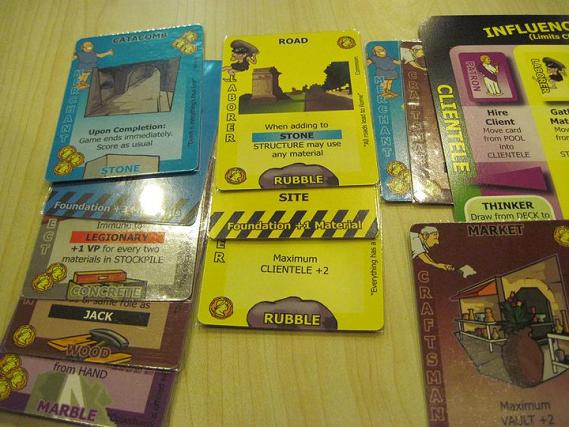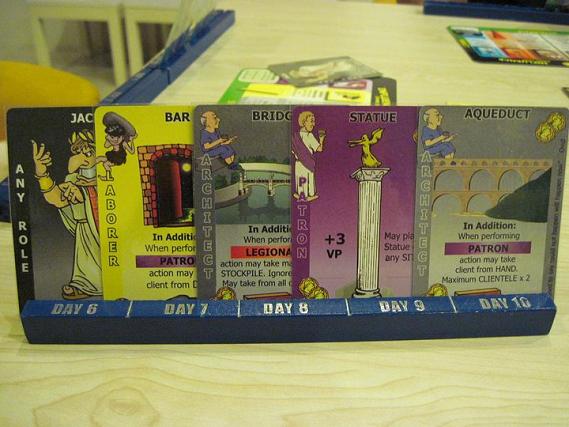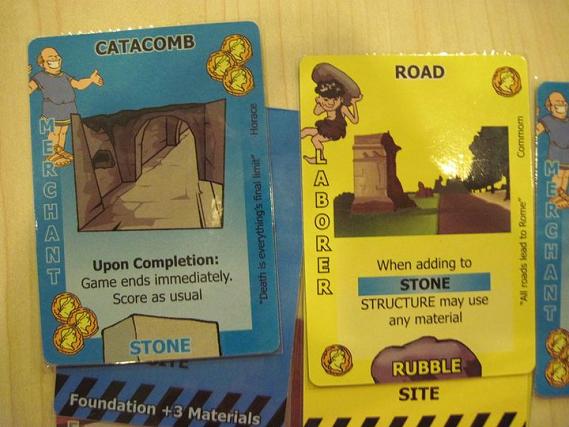
Due to its reputation as being a game that’s similar to Race for the Galaxy, Glory to Rome is something that I’ve been meaning to try. One reason is that I’ve liked clever card games ever since I first played CCGs. But over time, I’ve also found that card games are ideal for two players. I like heavy stuff like Agricola too, but they take a long time to play and often I get lazy about doing all the work needed to set a game up when it’s just two of us. That’s why our copy of Race for the Galaxy has seen a decent amount of play while it’s almost embarrassing how rarely we play BattleLore. There’s a lot to be said in favor of easy to set up games that are short enough that we don’t need to plan our schedules around them.
Not only does Glory to Rome fill the same niche, but it’s supposedly an even heavier game with much more player interaction to boot. In fact, Sean thought it was so complex that he asked us to play a learning game first, ignoring the effects of completed buildings and using only about half the deck. I don’t recall him doing that for RftG! Anyway, it’s involved enough that I don’t really feel up to covering the mechanics in detail, plus we’re entering the holiday season here, so I have a bunch of stuff to catch up on. So let’s go with the bullet-points:
- Ok, let’s deal with this first. I don’t think that this game is really as complex as advertised. My wife made the same point. I think Shan was disappointed. She probably hoped it would be harder. You need to learn the powers of the different roles, sure, but that’s what the handy reference card is for. I’d say that RftG is arguably harder to learn, because of its heavy use of iconography. What makes Glory to Rome feel complex is that the mechanics flow in a very unintuitive way, so that it’s hard to wrap your head around the implications of each action. But once again, it’s all down to thoroughly understanding the roles and how they work.
- Cards can be variously building materials, building types or roles, which sounds complicated. But it’s actually not too bad. Cards in hand can be buildings, roles or building materials, if using the Craftsman role. Cards in the pool can only be building materials to be moved into the stockpile or clients if using the Patron role. Of course, cards only appear in the pool if someone puts them there by playing them as roles. The key to learning this game is getting a good grasp of how the cards flow through the different game areas.
- Despite what first seems like an overwhelming number of cards, Glory to Rome doesn’t really have that many different cards. RftG certainly has much more variety. All cards of the same color also cost the same number of building materials to build and are worth the same number of points whether you turned it into a building or sold it into the vault. All cards of the same color also always represent the same role and building material. All that makes it easier to learn.

So after our first learning games, we’ve since played a couple more games of the real thing. We were initially apprehensive that it would take a long time to play, and Sean certainly indicated that this was so, but that wasn’t the case. Shan very quickly ended the first game by completing the Catacomb building. Our second game took longer and it was once again due to the Catacomb, but I don’t think that it was much more than what an average game of RftG would have taken. Some thoughts:
- It is indeed a lot more interactive than RftG. Very often, I get lazy about paying attention to the opponents’ tableau when playing RftG, so it much more of a multi-player solitaire thing. In Glory to Rome, players don’t put up that many buildings but each building’s effects are much more dramatic and can affect everyone else, so you need to pay attention to them.
- In RftG, many card combos and synergies have to do with just allowing the controlling player to earn more points. In Glory to Rome, by contrast, combos have powerful and far reaching gameplay effects. This is both and bad, I think. It’s good in that it makes the game more tense and encourages player participation. But it’s bad in that it exacerbates the randomness inherent in any game about drawing cards from a deck. In RftG a lucky hand means a player gets more points. In Glory to Rome, Shan’s combo of Roads and Catacomb in her starting hand was enough to let her win the game on its own.
- On a similar note, RftG uses any cards as resources while each building in Glory to Rome needs a specific building material. Unless you wait until you have enough of the needed materials either in your hand or in your stockpile before starting a building, getting the materials you need is somewhat random as well. I guess there are ways to mitigate that. You could throw a card of the color you need into the pool as a role and hope that the other players follow. But they might just play Jacks or choose to think instead. Still seems like a bit of a crapshoot to me.
- I’m not convinced Glory to Rome is well-balanced. Like I said, certain card combinations seem extraordinarily powerful. Similarly, even with just two games, it’s apparent that everyone favors the Craftsman role early in the game and the Merchant role later in the game. The Architect in particular compares very badly to the Craftsman. It’s easy to draw cards and use them as building materials to feed the Craftsman. It takes a lot more work to maneuver a card from the pool into your stockpile and from there into a building using the Architect. Frankly, if I dumped cards into my stockpile, I’d feel a lot more inclined to just sell them into the vault than to building something using them.
- Due to the unintuitive nature of its mechanics, I think the theme is pretty weak. It’s hard to relate any aspect of the rules to the stated theme of rebuilding Rome. I think RftG has Glory to Rome beat in this respect. I actually feel like I’ve developing a star-faring empire in RftG and Tom Chick wrote a blog post about how it’s possible to tell a coherent story from a game. I think Glory to Rome is very much the abstract manipulation of cards to maximize points.
Anyway, we still liked it enough that we’ve asked Sean to order a copy for us. I think I still like RftG more. I like its art and its theme, which are areas that Glory to Rome obviously scores very badly in. I also like that RftG has a more predictable playing time and seems less dependent on luck. On the other hand, Glory to Rome is a pretty clever game and I concede that there’s still plenty in it for me to discover. The Legionary role for example was underplayed in our game and there are probably interesting uses for it that we haven’t realized yet. I look forward to receiving our copy so that we can experiment with it more.

2 Responses to “Glory to Rome”
How come the road+Catacomb combo is broken?
Finishing the Catacomb doesn’t make you win automatically, you still need to have more points than the others.
Broken is hyperbole I guess, but it is a very powerful combo, exacerbated by its ability to end the game very quickly. But then it looks like Glory to Rome is a game of broken combos, so they balance each other out that way.
Leave a Reply